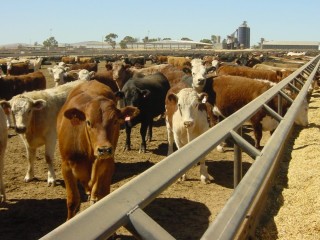 NSW DPI beef cattle officer Todd Andrews discusses the concept of Net Feed Intake and its use as a measure of feed efficiency for the purpose of genetic development
NSW DPI beef cattle officer Todd Andrews discusses the concept of Net Feed Intake and its use as a measure of feed efficiency for the purpose of genetic development
Net feed intake measures whether an animal eats more or less than expected for its weight and growth rate over a test period. Low NFI animals eat less than expected and are therefore more efficient.
The growth and economic advantages of efficient (low NFI) over inefficient (high NFI) steers in feedlots is consistent and heritable in paddock and feedlot trials.
For example, several comparisons of high and low efficiency lines developed from a single Angus beef herd at Trangie, NSW, have shown a considerable range in efficiency. The live animal measurements and carcase attributes of Angus steers from Low and High Net Feed Intake selection lines on pasture and in the feedlot are shown in Table 1 and 2.
Table 1: Steer performance at pasture
| Low NFI | High NFI | |
| Feed intake (kg/d) | 3.0 | 3.2 |
| Average daily gain (kg/d) | 0.50 | 0.42 |
| Feed conversion ration (kg feed/kg gain) | 6.4 | 8.5 |
Table 2: Steer performance in the feedlot
| Low NFI | High NFI | |
| Feed intake (kg/d) | 12.3 | 12.5 |
| Average daily gain (kg/d) | 1.53 | 1.49 |
| Feed conversion ratio (kg/kg) | 7.6 | 8.2 |
| Preslaughter to rib fat depth (mm)* | 10.2* | 11.6 |
| Preslaughter P8 fat depth (mm)* | 13.1* | 14.8 |
* indicates a significant difference between lines.
There are likely to be many reasons for the measured variation in efficiency. Differences in body partitioning (tendency to lay down fat vs. muscle) have been consistent however, with lowNFI having less subcutaneous fat than high NFI cattle (Table 2).
Though increased efficiency in pasture or lot-fed young animals is desirable, the tendency for efficient cows to be leaner could result in reduced female fertility. For example, breeding for low-NFI has been linked to delays in reaching puberty and conception after calving that could lead to reduced
pregnancy rates under conditions of low nutrition in a restricted joining season.
Research from the Beef CRC has also shown that differences between high and low efficiency lines are most pronounced when feed is readily available.
When diets approach maintenance levels however, there is minimal variation in the efficiency of feed use for basal metabolism.
This indicates that there is no difference in the energy required to maintain cow body weight when feed availability is low. The implication for producers is that during drought or other situations where nutrition is limiting, and when the benefits of reduced feed requirements would be maximised, there is little difference between the NFI lines.
As a result, there may in fact be some benefit in having a breeding herd of low efficiency (high NFI) cows. These cows have greater genetic potential to eat more and to lay down more fat when feed is plentiful (to be stored and mobilised as required) while the nutrition they require for survival when
feed is limiting is unaffected.
- This article originally appeared in the December 2011 edition of the NSW DPI Beef News newsletter

HAVE YOUR SAY